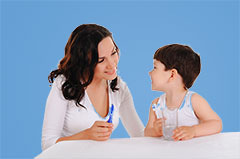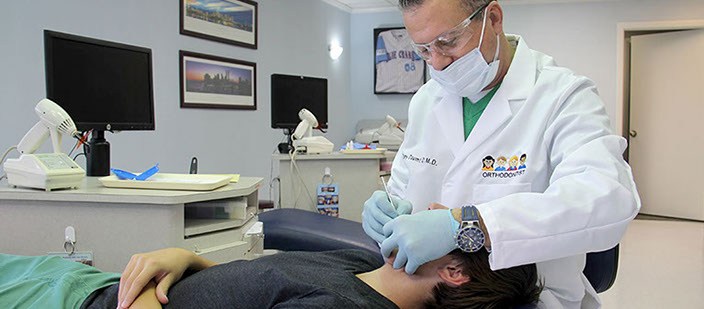CURRENT PATIENT
DO's & DON'Ts
BRUSHING & FLOSSING
EMERGENCY INFO
EATING HABITS
Please do not eat hard foods: nuts, ice, crisp taco shells, whole apples and carrots (cut them into pieces first), hard French bread crust and rolls, spare ribs, corn on the cob (cut the corn off the cob before eating), and popcorn. These foods risk breaking brackets and wires. Also beware of nail biting and pen or pencil chewing habits, since these can damage your braces. Do not eat sticky foods: taffy, caramels, bubble gum, sticky candy of any sort.
ABSOLUTELY NO!
Sticky Foods (sugarless or otherwise)
• Gum
• Caramels
• Sugar Daddies
• Starbursts
• Caramel Apples
• Sugar Babies
• Licorice
• Toffee
• Tootsie Rolls
• etc.
Hard Foods
• Jolly Ranchers
• Jaw Breakers
• Lolli-pops
• Nuts
• Bagels
• Apples (unless cut up)
• Pizza Crusts
• Carrots (uncooked, unless cut up)
• Doritos
• Pretzels
• etc.
BRUSHING AND FLOSSING 
The best ways to ensure a clean and healthy smile are brushing and flossing. Food particles can accumulate on teeth and around braces and over time, turn into plaque. The bacteria that results from this accumulation can lead to gum disease, tooth decay, and even loss of teeth. To avoid these problems while you are in orthodontic treatment, take special care of your braces, teeth, and gums to ensure you will have the best possible result.
BRUSHING
Use a toothbrush with soft bristles and a small strip of fluoride toothpaste.
When you brush your teeth, move the brush in small, circular motions to reach food particles that may be under you gum line. Hold the toothbrush at an angle and brush slowly and carefully, covering all areas between teeth, between braces, and the surface of each tooth. It will take you several minutes to thoroughly brush your teeth. Brush up on the lower teeth, down on the upper teeth, and the outside, inside, and chewing surface of your front and back teeth.
Brush your tongue and the roof of your mouth before you rinse.
FLOSSING
For areas between the teeth that a toothbrush can’t reach, use dental floss to remove food particles and plaque. Flossing takes more time and patience when you are wearing braces, but it is important to floss your teeth every day.
Put a small length of floss and slide it up and down between your teeth. You will be able to feel when the tooth is clean and hear the squeak of the floss against your clean teeth. Use care around your archwire and do not floss too forcefully around it or put too much pressure on it. After you floss between your archwire and braces, floss between your other teeth and gums.
EMERGENCY INFORMATION
What to do in Case of an Emergency
Call our office as soon as possible if you break or loosen any of your appliances. Please do not come directly to the office – by calling us, you will allow us to create a time to see you. Even if you have a regular appointment scheduled, call us immediately to notify us if you need an appliance repaired.
Loose Brackets or Bands
Call our office immediately for advice if a bracket or wire is loosened. The bracket may need to be re-fitted as soon as possible. You may have a situation that requires cutting a wire or sliding a bracket off a wire at night or over the weekend. If you need to cut a wire in case of emergency, you may use fingernail clippers that have been washed and sterilized in alcohol. Please call our office the next business day so that we may schedule an appointment for you.
Discomfort with Orthodontic Treatment
During the first week after your braces are in place and routine adjustments are complete, you will likely feel some pain, soreness, or discomfort. You may take acetaminophen or other non-aspirin pain relievers while you adjust to your new braces. A warm wash cloth or heating pad may reduce the soreness in your jaws.
Lost Separators
Patient's may lose a separator during treatment. Do not worry. If you lose a separator call the office.
Wire Irritations
Sometimes discomfort caused by a wire on your braces can be resolved by moving the wire away from the irritated area with a cotton swab or eraser. If the wire will not move, try covering the end of it with a small piece of cotton or small amount of wax. If the wire is painful, you can cut it with nail clippers or scissors that have been washed and sterilized.
